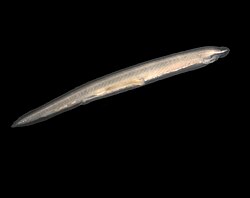Lancelet
The lancelets, also known as Cephalochordata or Leptocardii, are a group of primitive chordates which were formerly called Amphioxus. It includes Pikaia.
| Cephalochordata | |
|---|---|

| |
| Lancelet (Branchiostoma lanceolatum) | |
| Scientific classification | |
| Kingdom: | |
| Phylum: | |
| Subphylum: | Owen, 1846
|
| Class: | Leptocardii
|
Lancelets are the modern survivors of an ancient chordate lineage, with a fossil record dating back to the Cambrian period. The lancelets are usually said to be the sister group of the craniates. They are a small group of about 30 species in two genera.
Lancelets are usually found buried in sand in shallow parts of temperate or tropical seas. In Asia, they are harvested commercially as food for humans and domesticated animals. They are an important object of study in zoology as they give indications about the origin of vertebrates.[1]
Relationships
Lancelets serve as an intriguing comparison point for tracing how vertebrates have evolved and adapted. Although lancelets split from vertebrates more than 520 million years ago, their genomes hold clues about evolution, particularly how vertebrates have employed old genes for new functions.[2] They are regarded as similar to the archetypal vertebrate form.
The genome of the Florida lancelet (Branchiostoma floridae) has been sequenced.[3] "Most authors regard amphioxus as the closest relative of the Vertebrata on the basis of 10–15 [morphological] features that are not seen in tunicates".[4]
Lancelet Media
References
- ↑ Gee, Henry 2008. Evolutionary biology: The amphioxus unleashed. Nature 453: 999-1000.
- ↑ Worm-like marine animal providing fresh clues about human evolution Newswise, Retrieved on July 8, 2008.
- ↑ Putnam N.H. et al 2008. The amphioxus genome and the evolution of the chordate karyotype. Nature 453: 1064–1071. [1]
- ↑ Michael J. Benton 2005. Vertebrate Palaeontology. 3rd ed, Oxford: Blackwell. p8 ISBN 0-632-05637-1




